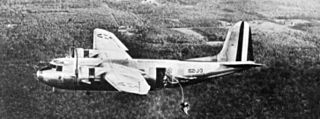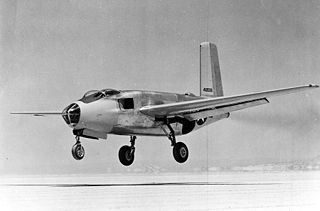
The Martin B-10 was the first all-metal monoplane bomber to be regularly used by the United States Army Air Corps, entering service in June 1934. It was also the first mass-produced bomber whose performance was superior to that of the Army's pursuit aircraft of the time.

The Consolidated B-24 Liberator is an American heavy bomber, designed by Consolidated Aircraft of San Diego, California. It was known within the company as the Model 32, and some initial production aircraft were laid down as export models designated as various LB-30s, in the Land Bomber design category.

The Douglas B-18 Bolo is an American heavy bomber which served with the United States Army Air Corps and the Royal Canadian Air Force during the late 1930s and early 1940s. The Bolo was developed by the Douglas Aircraft Company from their DC-2 as a replacement for the Martin B-10.

The Martin B-26 Marauder is an American twin-engined medium bomber that saw extensive service during World War II. The B-26 was built at two locations: Baltimore, Maryland, and Omaha, Nebraska, by the Glenn L. Martin Company.

The Douglas SBD Dauntless is a World War II American naval scout plane and dive bomber that was manufactured by Douglas Aircraft from 1940 through 1944. The SBD was the United States Navy's main carrier-based scout/dive bomber from mid-1940 through mid-1944. The SBD was also flown by the United States Marine Corps, both from land air bases and aircraft carriers. The SBD is best remembered as the bomber that delivered the fatal blows to the Japanese carriers at the Battle of Midway in June 1942. The type earned its nickname "Slow But Deadly" during this period, along with a rarely-used accompanying nickname of "Furious D."

The Douglas XB-42 Mixmaster was an experimental American bomber aircraft, designed for a high top speed. The unconventional approach was to mount the two engines within the fuselage driving a pair of contra-rotating propellers mounted at the tail in a pusher configuration, leaving the wing and fuselage clean and free of drag-inducing protrusions.

The Northrop YB-35/XB-35, Northrop designation N-9 or NS-9, were experimental heavy bomber aircraft developed by the Northrop Corporation for the United States Army Air Forces during and shortly after World War II. The airplane used the radical and potentially very efficient flying wing design, in which the tail section and fuselage are eliminated and all payload is carried in a thick wing. Only prototypes and pre-production aircraft were built, although interest remained strong enough to warrant further development of the design as a jet bomber, under the designation YB-49.

The Douglas DC-5 was a 16-to-22-seat, twin-engine propeller aircraft intended for shorter routes than the Douglas DC-3 or Douglas DC-4. By the time it entered commercial service in 1940, many airlines were canceling orders for aircraft. Consequently, only five civilian DC-5s were built. With the Douglas Aircraft Company already converting to World War II military production, the DC-5 was soon overtaken by world events, although a limited number of military variants were produced.

The Douglas A-20 Havoc is an American light bomber, attack aircraft, night intruder, night fighter, and reconnaissance aircraft of World War II.

The Boeing XB-15 was a United States bomber aircraft designed in 1934 as a test for the United States Army Air Corps (USAAC) to see if it would be possible to build a heavy bomber with a 5,000 mi (8,000 km) range. For a year beginning in mid-1935 it was designated the XBLR-1. When it first flew in 1937, it was the most massive and voluminous airplane ever built in the US. It set a number of load-to-altitude records for land-based aircraft, including carrying a 31,205 lb (14,154 kg) payload to 8,200 ft (2,500 m) on 30 July 1939.

The Douglas Y1B-7 was a 1930s American bomber aircraft. It was the first US monoplane given the B- 'bomber' designation. The monoplane was more practical and less expensive than the biplane, and the United States Army Air Corps chose to experiment with monoplanes for this reason. At the time the XB-7 was ordered, it was being tested by Douglas Aircraft as an observational plane.

The Fokker XB-8 was a bomber built for the United States Army Air Corps in the 1930s, derived from the high-speed Fokker O-27 observation aircraft.
The Martin XB-16, company designation Model 145, was a projected heavy bomber designed in the United States during the 1930s.

The North American XB-21 and sometimes referred to by the name "Dragon", was a prototype bomber aircraft developed by North American Aviation in the late 1930s, for evaluation by the United States Army Air Corps. Evaluated against the Douglas B-18 Bolo, it was found to be considerably more expensive than the rival aircraft, and despite the ordering of a small number of evaluation aircraft, only the prototype was ever built.

The Douglas B-23 Dragon is an American twin-engined bomber developed by the Douglas Aircraft Company as a successor to the B-18 Bolo.

The Martin XB-48 was an American medium jet bomber developed in the mid-1940s. It competed with the Boeing B-47 Stratojet, which proved to be a superior design, and was largely considered as a backup plan in case the B-47 ran into development problems. It never saw production or active duty, and only two prototypes, serial numbers 45-59585 and 45-59586, were built.

The Allison V-3420 was a large experimental piston aircraft engine, designed in 1937 by the American Allison Engine Company.

The Douglas XB-43 Jetmaster is an American 1940s jet-powered prototype bomber. The XB-43 was a development of the XB-42, replacing the piston engines of the XB-42 with two General Electric J35 engines of 4,000 lbf (17.8 kN) thrust each. Despite being the first American jet bomber to fly, it suffered stability issues and the design did not enter production.

The Sikorsky XBLR-3 was an experimental bomber design developed by Sikorsky Aircraft to compete in the United States Army Air Corps "Project D" design competition of 1935. In March 1936 the USAAC canceled the Sikorsky XBLR-3 in favor of the remaining two competitors: the Boeing XBLR-1 and the Douglas XBLR-2. The XBLR-3 was one of the last fixed wing aircraft designed by the Sikorsky company.

The North American NA-40 was an American prototype bomber aircraft developed by North American Aviation in the late 1930s for evaluation by the United States Army Air Corps. Although unsuccessful, it led directly to the North American B-25 Mitchell medium bomber.





















